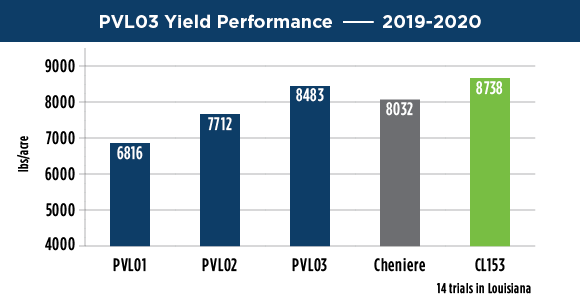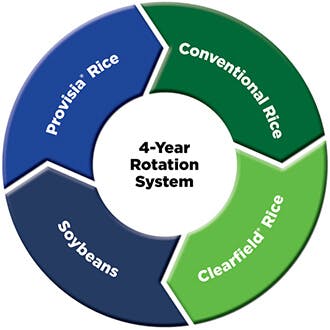More Soybeans in 2021 Sets Up Provisia Rotation
02/11/2021
Higher soybean prices, resulting from tightening global supplies and large purchases by key customers like China, will likely lead to rice farmers rotating more of their acres to soybeans this season. When they do, they will have a great opportunity to set their operations up to move to the Provisia® Rice System in 2022 and effectively clean up costly weedy rice and herbicide-resistant grasses and red rice. It also will allow them to begin taking more of a systems approach to weed control in rice.
It’s good timing, since there will be more availability in 2022 of Horizon Ag PVL03, the latest Provisia rice variety. PVL03 is expected to be in good supply after a very limited launch this season. The new variety, developed at the LSU Ag Center, provides yield potential comparable to the most popular conventional and Clearfield® varieties, along with blast resistance. The Provisia Rice System, with Provisia herbicide, is recognized as one of the most effective weed management tools available for Southern rice today.

Recent USDA reports project that stockpiles of soybeans in 2021 will shrink to their lowest levels since 2014. At the same time, the average farm-gate price for soybeans this marketing year is expected to be the highest since 2014. As a result, soybean acreage in the South should increase as farmers take advantage of profitable prices and the benefits that come with crop rotation.
Although the Provisia Rice System has already had a tremendous impact in many areas of the South, one of the challenges to adopting the system to date is that farmers must prepare and plan for the technology shift, taking into consideration when they’ve last used imazethapyr, the active ingredient in Newpath® and Preface™ herbicides. Imazethapyr can stay active in the soil for as long as two years and create the potential for carryover issues in Provisia and conventional rice. In a soybean/rice rotation, it is recommended to go least two years without an imazethapyr application to prevent the risk of carryover. In a continuous rice system, it is recommended to go at least three years without an imazethapyr application.
In recent years, many Southern farmers have experienced serious problems with the weedy rice complex and herbicide-resistant grasses in their fields, particularly where they have relied on a rice monoculture for multiple seasons. In some cases, production has been so adversely impacted that those fields have had to be moved out of rice production. An increase in soybean plantings in 2021 should open the door for a significant move to Provisia rice next season and help bring those problem fields back into profitable production.
When the Provisia Rice System was launched with Horizon Ag PVL01 in 2018, some were hesitant to immediately shift to the technology because of the lower yield potential of the initial variety, PVL01, or because their crop rotation wasn’t set to accommodate it. Even with the rollout of the second Provisia variety, Horizon Ag PVL02, which is higher yielding than PVL01, adoption has been driven more by the urgent need to clean up infested fields vs. taking a systems approach to weed management.
With new Horizon Ag PVL03, however, farmers can expect even higher yield potential, milling advantages and blast resistance. Louisiana trials in 2019 and 2020 show PVL03 yielding almost 8,500 pounds per acre, out-yielding Cheniere and putting it on par with top-selling Clearfield lines like CL153.

Just as important, it not only will provide an opportunity for outstanding control of the weedy rice complex and herbicide-resistant grasses but also can prevent the development of resistant grasses when used in a systems approach that rotates herbicide chemistry. The strong performance potential of PVL03 means farmers can now adopt a four-year rotation system that consists of soybeans, Provisia rice, conventional rice and Clearfield rice and achieve outstanding results.

As with any technology, good stewardship will be the key to the Provisia Rice System’s viability as an effective tool for rice farmers. It is recommended to not plant Provisia varieties two years in a row. You also want to follow Provisia with soybeans if possible, since it may take three to four years to reduce heavy weedy rice populations. A rotation of soybeans, Provisia rice and soybeans will go a long way toward reducing the presence of weedy rice in fields and winning back that acre.
Once weedy rice populations are under control, you can plant back to a Clearfield variety or conventional variety, since there are no plant-back restrictions after Provisia rice. In this situation, planting a Clearfield variety is preferred over hybrid, since there is less risk of weedy rice developing in a pure-bred line when it is time to go back to an imazethapyr-resistant rice.
